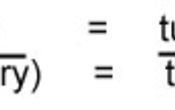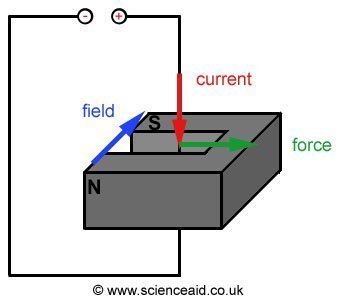Electromagnetism
Edited by Jamie (ScienceAid Editor), Taylor (ScienceAid Editor)
Electric Motor
When an electric current passes at a right angle to a magnetic field, a force is produced, which moves perpendicular to the magnetic field. Have a look at the diagram below to help you understand this.
Put your Index finger in the direction of the current; Middle finger in the direction of the magnetic field; and point your thumb up and it should point in the direction of the force.
This phenomenon can be used to produce a rotation in what is called a simple DC motor. This principle is also applied to make dynamos, which are used to generate electricity; this is explained below.
Electromagnetic Basics
A voltage is created in a conductor when it is moved through a magnetic field. So moving a magnet through a coil of wire produces the same effect. The size of this voltage can be increased by:
- 1Increasing the number of turns on the coil.Advertisement
- 2Increasing the speed of the magnet.
- 3Increasing the strength of the magnetic field.
This effect may seem boring and useless, but because this process is used to generate electricity, and you wouldn't be able to read this on your computer right now - without it.
Transformers
The above diagram shows a step up transformer because it increases the voltage. Step up and step down transformers are used all over the country for your domestic electricity supply. They change the voltage up and down for the different stages of its transportation: increasing from the power plant to electric cables, decreasing from cables to your home. Your stereo has a step up transformer. When you turn up the volume, it increases the voltage. The secondary voltage is 'more' than the initial. When the secondary voltage is 'less' than the initial, it's called a step down transformer. An example would be fluorescent lights - as it requires more power to turn them on, than to run them.
There is a relationship between the primary (in) and secondary (out) voltages on the transformer depending on the number of turns the wire takes around the magnet.
Referencing this Article
If you need to reference this article in your work, you can copy-paste the following depending on your required format:
APA (American Psychological Association)
Electromagnetism. (2017). In ScienceAid. Retrieved Apr 18, 2024, from https://scienceaid.net/physics/electricity/electromagnetism.html
MLA (Modern Language Association) "Electromagnetism." ScienceAid, scienceaid.net/physics/electricity/electromagnetism.html Accessed 18 Apr 2024.
Chicago / Turabian ScienceAid.net. "Electromagnetism." Accessed Apr 18, 2024. https://scienceaid.net/physics/electricity/electromagnetism.html.
If you have problems with any of the steps in this article, please ask a question for more help, or post in the comments section below.
Comments
Article Info
Categories : Electricity
Recent edits by: Jamie (ScienceAid Editor)










